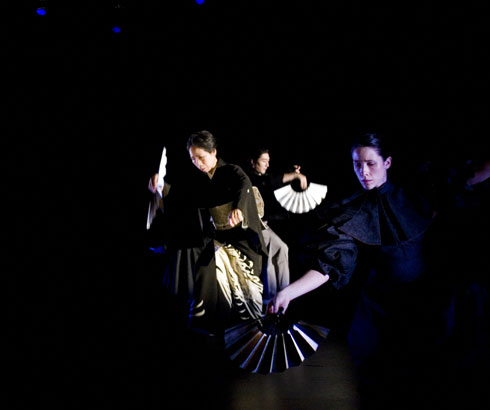
Tyler Tyler performs at Global Dancefest in Albuquerque
Tyler Tyler director Yasuko Yokoshi explained during a post-performance talk at Global Dancefests N4th Theater in Albuquerque that in traditional Japanese dance, the dancer both becomes the element or character and is an observer of that element or character. “The dancer is only a medium, a vessel,” she says; too much of the dancers ego is not appropriate.
Contrast this nuanced, controlled style with the flamboyance of modern Western dance, weave them together in an abstract deconstruction of a classic work of Japanese medieval literature, layer the eleven-part performance with the Buddhist ideology of impermanence, and the result is Tyler, Tyler, an exquisite collaboration of East and West.
Only the soft shuffle of feet are heard as the show begins with American performer Julie Alexander gingerly carrying a miniature piano onto the stark, all-black stage. She kneels to sing a Kouta song (“little song”) for Japanese performer Kuniya Sawamura as he embodies a famous samurai warrior contemplating revenge, in a complex juxtaposition of precise, drunken movement.
The two do not face each other, interacting in an indirect manner indicative of most of the performance. The performers are often in sync, as in the fourth scene, where all five dancers perform Shima no Senzai, an expression of the flow of water, utilizing silver fans to reveal how this common, precious resource can become lyrical, protective and vengeful. However, rarely do the performers look at one another, touch, or intertwine despite the emotional surges depicting the betrayal of a lover, loss of a son, or the pride of a warrior.

Choreographer Yasuko Yokoshi
The occasional clash of culture is comedic and uncomfortable. When Japanese performer Naoki Asaji sings an iconic American pop song by the Carpenters, complete with stilted accent, we laugh at his attempt, but pity the interpretation. Conversely, a betrayal forces Julie Alexander, who “comes from the West” to “dance for the East.” In this scene, her flagrant gestures are inappropriate, silly and she also speaks a song that is absurdly melodramatic, saying, “My lover is gone”¦but what the hell”¦my knee hurts”¦what will happen to my life?” Perhaps revealing the inevitable intertwining of all cultures, and despite strong traditions and history, the futility of attempts to retain control of “authenticity.”
As a Western audience member accustomed to a linear plot, I struggled to maintain a storyline. Based in historical fact, the medieval Tale of the Heike does document our incalculable desire to dominate despite an inevitable fall from power, however, “This is an abstract performance,” says Yokoshi, gesturing in a circular motion and offering insight into her artistic process, “not cause and effect, but visual and visceral.”

